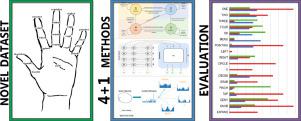Computers & Graphics ( IF 2.5 ) Pub Date : 2021-07-10 , DOI: 10.1016/j.cag.2021.07.007 Ariel Caputo 1 , Andrea Giachetti 1 , Simone Soso 1 , Deborah Pintani 1 , Andrea D’Eusanio 2 , Stefano Pini 2 , Guido Borghi 3 , Alessandro Simoni 2 , Roberto Vezzani 2 , Rita Cucchiara 2 , Andrea Ranieri 4 , Franca Giannini 4 , Katia Lupinetti 4 , Marina Monti 4 , Mehran Maghoumi 5 , Joseph J. LaViola Jr 5 , Minh-Quan Le 6 , Hai-Dang Nguyen 6 , Minh-Triet Tran 6

|
Gesture recognition is a fundamental tool to enable novel interaction paradigms in a variety of application scenarios like Mixed Reality environments, touchless public kiosks, entertainment systems, and more. Recognition of hand gestures can be nowadays performed directly from the stream of hand skeletons estimated by software provided by low-cost trackers (Ultraleap) and MR headsets (Hololens, Oculus Quest) or by video processing software modules (e.g. Google Mediapipe). Despite the recent advancements in gesture and action recognition from skeletons, it is unclear how well the current state-of-the-art techniques can perform in a real-world scenario for the recognition of a wide set of heterogeneous gestures, as many benchmarks do not test online recognition and use limited dictionaries. This motivated the proposal of the SHREC 2021: Track on Skeleton-based Hand Gesture Recognition in the Wild. For this contest, we created a novel dataset with heterogeneous gestures featuring different types and duration. These gestures have to be found inside sequences in an online recognition scenario. This paper presents the result of the contest, showing the performances of the techniques proposed by four research groups on the challenging task compared with a simple baseline method.
中文翻译:

SHREC 2021:野外基于骨架的手势识别
手势识别是在混合现实环境、非接触式公共信息亭、娱乐系统等各种应用场景中实现新颖交互范式的基本工具。如今,手势识别可以直接从由低成本追踪器 (Ultraleap) 和 MR 耳机 (Hololens、Oculus Quest) 或视频处理软件模块 (例如 Google Mediapipe) 提供的软件估计的手部骨骼流中执行。尽管最近在骨骼的手势和动作识别方面取得了进展,但目前尚不清楚当前最先进的技术在现实世界场景中的表现如何,以识别各种不同的手势,正如许多基准测试所做的那样不测试在线识别和使用有限的词典。这激发了 SHREC 2021 的提议:在野外跟踪基于骨架的手势识别。对于本次比赛,我们创建了一个新颖的数据集,其中包含具有不同类型和持续时间的异构手势。这些手势必须在在线识别场景中的序列中找到。本文展示了比赛的结果,展示了与简单的基线方法相比,四个研究小组提出的技术在具有挑战性的任务上的表现。

























 京公网安备 11010802027423号
京公网安备 11010802027423号